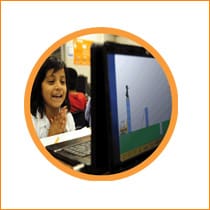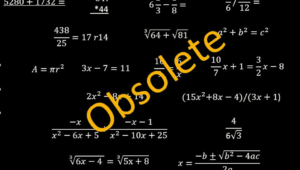Finally, Math Apps Show R.E.S.P.E.C.T.

There are no really good math apps out there. I’ve been convinced of this for some time based on nearly a decade of trying everything from online courses to video-game-like drills to the more recent iPad apps and flash cards. Available offerings tend to be inauthentic, in that they encourage rote procedures over real problem solving. They tend to be uninspired – either a direct translation of textbook approaches from the lecture hall to the video screen, or drill-and-kill practice with a veneer of video gaming that is intended to motivate students. Worst of all, they tend to be disrespectful of our students’ capacities, of their curiosity, and of their time. This week, though, I had the chance to play around with ST Math and found math software that actually treats us with respect.
Over the past decade, the promise of technology has been to make learning more personalized and engaging. In the case of math, specifically, computer-based learning would:
- Allow students to move through the curriculum at their own pace through computer-aided independent study
- Provide a game-like experience that engages students and helps them stay on task longer
- Provide adaptive learning that gives each student the next best lesson for learning, not making them spend time on material they have already mastered
- Provide an immersive experience where rote skills are the side effect of applying higher order thinking; and
- Provide experiences that are customized to an individual’s style and preferences.
This promise has been unfulfilled for many reasons.
Where Online Math Games Miss the Mark
Online math courses are intended to let students to work at their own pace. Traditionally in independent study, students have read textbooks and worked problems on their own. With technology they have the added benefit of video lectures to explain the material.
The problem with this approach, with or without technology, is the underlying assumption that to learn math, factual and procedural knowledge is transferred from an expert to a student via books and lectures even though education science tells us that this works poorly. Good educators ask students to learn math through inquiry, exploration, and group work, none of which are available from textbooks and video lectures – these can’t provide feedback. In effect, students find themselves with the forced choice of good pedagogy in lockstep with students who are the same age but at different points in their learning arc, or tedious self-paced trudging through traditional materials, whether digital or print. Sigh.
Math apps serve a different purpose than online curriculum – they provide drill and practice with mathematical concepts using elements of video gaming to motivate students. They assume that the actual learning of the concept or skill has already happened, most likely in the classroom, and engage the student in practicing that skill. These apps generally include game-like play with the assumption that animated characters and activities like shooting or racing will motivate students to stay on task longer and learn more math.
The problem with this approach is that it is artificial and inauthentic – it is trying to fool kids into thinking that math is gaming. In effect, what these apps tend to do is to bribe students to do some math in return for being allowed to pull a trigger or push a throttle or otherwise engage in some game play which is completely unrelated to learning math. As a result, time on task is divided between doing math and playing games with no real cognitive overlap. This is not only disrespectful of students’ time, but reinforces the notion that math is something unappealing that requires external motivation to engage student interest.
Some of the online curricula and math drill apps have an element of adaptive learning paths. They will provide diagnostic tests to see whether a student has already mastered a unit, and allow them to skip it if so. Essentially these are the digital equivalent of the pretests found in traditional textbooks. The learning is still linear, it just allows the student to repeat or skip material as needed. Again, there is no respect for a student’s curiosity and capacity to follow different paths of learning, skipping lightly over some materials, digging deeply into interesting topics, going off on interesting tangents and detours and eventually covering the material.
As for learning basic skills as a side effect of higher order problem solving, I wonder whether that is a pipe dream or whether it is real. If it is, indeed, possible I haven’t found the approaches or tools that enable a mom to provide those learning experiences to her own kids. (So, if you know of any, please share: I currently have a policy in my home involving bribery to address the problem of gaining fluency in tedious basic skills!!)
As profoundly frustrating as these tools are, I do love them – don’t get me wrong. They have made it possible for us to have options in teaching and learning math that we otherwise wouldn’t have had. The flaws they have come from translating directly from the physical to the digital – something analogous to dictating your e-mails to a secretary. They are very much first generation products.
And although promise of technology may not have been fulfilled just yet, there are signs that some of those advances are just around the corner. I am encouraged by online learning that has live teachers who can help students struggle with great problems until they achieve the mindset where they have real appreciation for the tools they need to solve them. I am encouraged by the math skills that are the unintended side effects of serious game play as in theorycrafting. And I am very encouraged by a new breed of math app that breaks all my preconceptions and treats students with respect.
ST Math Delivers a New Approach to Math Games
ST Math consists of a series of games that have the clean, simple design of traditional casual video games. There are no lectures. Heck, there aren’t even instructions. Just as Angry Birds teaches you to hit pigs through trial and error, these games allow you to discover mathematical concepts the same way. They have a simple goal: Allow the Jiji, the penguin, to cross the bridge. If you solve the math puzzle he will. Otherwise your miscalculations turn into debris on the bridge that prevent him from crossing.
With fractions, for example, you are asked to find the numerical representation (say 3/2) of some pie slices. Your answer gets turned into a second set of pie slices and compared to the original set – an alien spaceship beams up all the slices that match and the bridge is littered with any left over slices keeping Jiji on his own side. Take a look at the math tour video that describes the product – words are a poor medium for conveying its coolness and simplicity.
What makes these apps so different from what has gone before?
- Since students learn by trial and error, rather than lecture and test or drill and kill, independent study is now about independent discovery. By playing the game, students get an experiential understanding of mathematical concepts. This is not only a far better way to learn than by lecture, it gives ownership of learning to the student rather than the teacher or the software.
- The experience is not only game-like, it’s actually a game. Mastering the game itself is what gives students mathematical understanding – gaming is not a bribe for enduring old-school tedious learning.
- As with any game, mastery leads to new content and new challenges. Students are engaged and learn at their own pace, unlocking new content as they conquer the old.
- In the best aspirations of the use of technology, these games make testing unnecessary. Playing the game constitutes both a learning experience and a continual formative assessment.
Much as with a live teacher, students wrestle with great higher-order conceptual problems first, gaining the mindset that lets them appreciate, understand, and use traditional mathematical tools for solving them. They receive instant feedback, and can literally “see” what they understand and what they have yet to grasp.
This type of math app is respectful of students’ time, capacities, and intrinsic motivations. It will definitely have an impact in the classroom, but I suspect that it’s real disruptive potential lies outside of formal schooling. This is the first math software I’ve seen that makes it possible, and even likely, that students will enjoy learning math at home without requiring parents to become math teachers. As the beginning of a platform that gives ownership of learning back to the family, this technology has the potential to disrupt the home learning products market more thoroughly than the schooling market. My sincere hope is that we will see this made available to parents and kids very soon.
MIND Research Institute is a Getting Smart Advocacy Partner.





David Wees
I really like what the Mind Research team has come up with, and I agree with you, they are among the best math specific apps on the market.
The only complaint I have is the cost of using their system. It was $10,000 for 200 students to use for a year, and $45,000 for a full k - 5 site license. This is more than the cost of a beginning teacher! I'm just going to go out on a limb here and suggest that most schools cannot afford this.